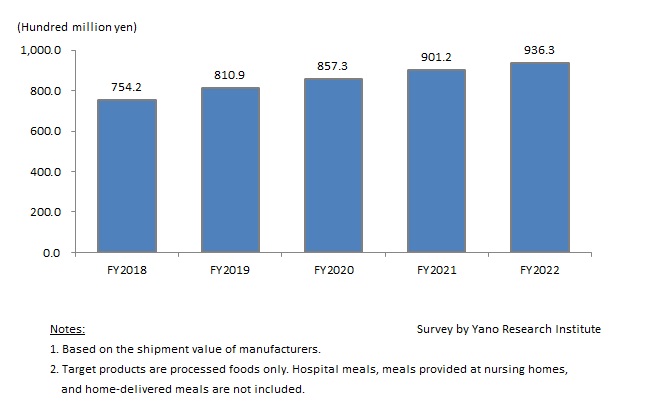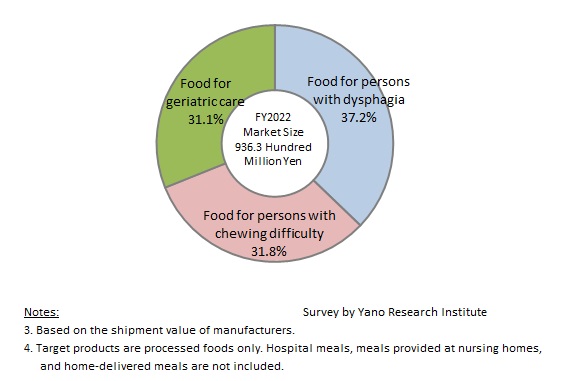No.3544
Market of Food for Persons with Dysphagia, Food for Persons with Chewing Difficulty, & Food for Geriatric care: Key Research Findings 2024
Amid Rising Concern for Increase of Seniors Requiring Long-term Care, Kitchen Staff Shortage at Hospitals & Nursing Homes, and Undernutrition of Elderly Persons, Market of Food for Persons with Dysphagia, Food for Persons with Chewing Difficulty, and Food for Geriatric Care Show Steady Growth
Yano Research Institute (the President, Takashi Mizukoshi) has conducted a survey on the domestic market of food for persons with dysphagia, food for persons with chewing difficulty, and food for geriatric care, and found out the trends by segment, the trends of market players, and future perspectives.


Market Overview
The market of processed food for elderly persons and patients with swallowing and/or chewing difficulty (food for persons with dysphagia, food for persons with chewing difficulty) and the market of food for senior persons in need of extra nutrition as their appetite decline (food for geriatric care) are showing steady growth. The market size of food for persons with dysphagia, food for persons with chewing difficulty, and food for geriatric care in FY2022 are estimated at 34,800 million yen (103.2% on year-on-year basis), 29,730 million yen (105.4%), and 29,100 million yen (103.2%), respectively.
Looking into detail of each market, the demand for the food for persons with dysphagia is increasing at hospitals and nursing homes, where the number of inpatients and persons admitted to the facilities are increasing. The demand for the foods for persons with chewing difficulty is rising at nursing homes due to compelling reason for simplifying cooking process, which is stemming from a serious shortage of kitchen staffs at those facilities. Meanwhile, associated with the rise of public consciousness for undernutrition of elderly persons, the demand for food for geriatric care is expanding not only at hospitals and nursing homes but also among older adults at home (regardless of their health condition).
Noteworthy Topics
Environment Surrounding the Market of Food for Persons with Dysphagia, Food for Persons with Chewing Difficulty, & Food for Geriatric Care
Regarding the food for persons with dysphagia, the variety of products increased, and improvements have been made in terms of convenience, safety, taste, and texture. For example, hydrating jellies (jelly drops) and jelly cups become widely available. Amid the national promotion of in-home medical care and nursing care (Community-Based Integrated Care System), purchase orders from patients at home and their caregivers are increasing, in addition to the orders from hospitals and nursing homes. Nevertheless, at-home consumption is not a major driver of the market, because giving food to persons with dysphagia needs supervision by a healthcare provider.
Food for person with chewing difficulty is struggling commercially, as consumer awareness of the products is still low. Manufacturers are having hard time persuading retailers to shelve their products regularly. Hospitals and nursing homes are discouraged of using soft moist foods (minced & moist foods) because of its price, which tends to be higher due to processing cost. Meanwhile, the demand for pureed meals (blenderized meals) for professional use is boosting the market growth against the backdrop of kitchen staff shortage at hospitals and nursing homes.
Food for geriatric care has been used as a supplementary food at hospitals and nursing homes. For elderly persons, decreased food intake and consequential undernutrition increase the risk of osteoporosis, sarcopenia (the loss of skeletal muscle mass and strength as a result of aging) and frailty (a progressive age-related decline in physiological systems), even if they do not have dysphagia. Backed by the rising awareness of taking high nutrition/energy foods to prevent elderly persons becoming in need of long-term care, the market is expanding steadily.
Future Outlook
Stable expansion is expected for the market of food for persons with dysphagia. With price revision, the market foresees further growth in FY2023. However, the growth rate is forecasted to wane in the future, as the number of persons with dysphagia is likely to reach a plateau while price competition intensifies.
We project that the market of food for persons with chewing difficulty will grow by several percent per year. Commercial sales is expected to expand for soft moist meal (minced & moist foods), mainly through mail order. On the other hand, the demand for pureed meals (blenderized meals) for professional usage is forecasted to augment as a shortage of kitchen staffs at hospitals and nursing homes will further necessitate the use of processed foods.
The demand for food for geriatric care is growing constantly as supplementary food (snacks and desserts) at nursing homes, as a means to prevent/manage undernutrition. However, in response to repeated price hikes of food in general due to soaring material prices, the market is witnessing nursing homes prioritizing daily cuisine (staple food, main dishes, and accompanying dishes) and decreasing the frequency of using food for geriatric care. If the price rise of food products in general continues, growth of the market of food for geriatric care may be impeded hereafter.
Research Outline
2.Research Object: Manufacturers of food for persons with dysphagia, food for persons with chewing difficulty, and food for geriatric care
3.Research Methogology: Face-to-face interviews by our specialized researchers (including online interviews), survey via telephone, and literature research
Market of food for persons with dysphagia, food for persons with chewing difficulty, and food for geriatric care
In this research, the market of food for persons with dysphagia refers to processed foods mainly for older adults and patients with swallowing difficulty, and the market of food for persons with chewing difficulty indicates processed foods for elderly persons and patients with chewing difficulty. The market of food for geriatric care implies foods processed with complementary nutrients and nutritional value for seniors, which are designed to prevent elderly persons to be in a physical condition that requires long-term care. Size of the markets are calculated based on the shipment value of manufacturers. Note that meals provided at nursing homes, hospital meals, and home-delivered meals are not included.
<Products and Services in the Market>
Food for persons with dysphagia (pureed food, thickening/gelling agent, dessert base, hydrating jelly [jelly drops]); food for persons with chewing difficulty (soft moist foods, minced & moist foods, pureed meals [blenderized food], others [jelly, etc.]); food for geriatric care (high-protein meal, energy food for older adults)
Published Report
Contact Us
The copyright and all other rights pertaining to this report belong to Yano Research Institute.
Please contact our PR team when quoting the report contents for the purpose other than media coverage.
Depending on the purpose of using our report, we may ask you to present your sentences for confirmation beforehand.